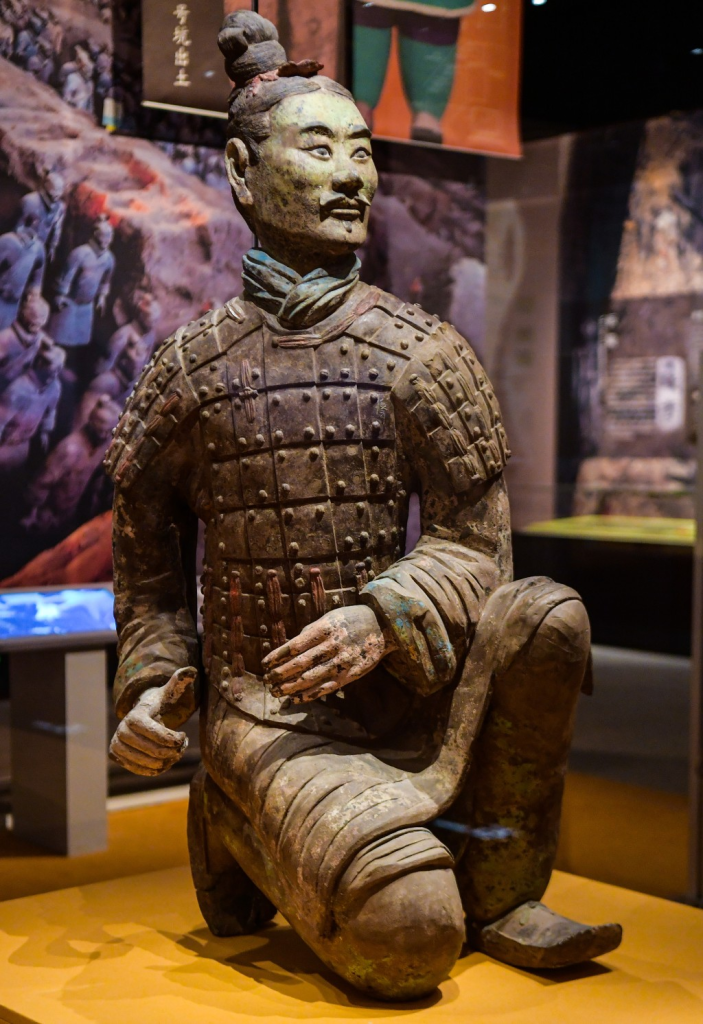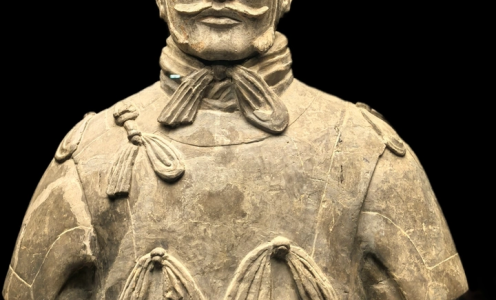For centuries, whispers and local tales have hinted at something extraordinary hidden beneath the unassuming fields near Xi’an, China 🇨🇳. Farmers occasionally unearthed pottery shards while tilling, attributing them to a legendary underground army 🪖. Yet, these were dismissed as mere urban legends passed down through generations. Little did anyone suspect the breathtaking reality lying dormant, poised to rewrite history 📜. The Terracotta Warriors, a silent legion guarding an emperor’s secrets, were ready to emerge.

March 1974: The Earth Speaks 🌍
In the spring of 1974, the Lintong District faced an unusually dry season. Xiyang Village’s farmers desperately sought a new water source 💧 for their crops. Led by Yang Zhifa, a group, including his brothers and a neighbor, decided to dig a well in an unremarkable piece of land. Their livelihood hinged on water. But the discovery they made was of a far deeper essence.
As they dug, the work became unexpectedly difficult ⛏️. Shovels struck something hard and unyielding. Initially, they assumed it was a rock, a common obstacle in the area. But as they cleared the reddish soil, they noticed something different. It was a curved terracotta surface. Brushing away more earth, they uncovered a neck, then a head, with clearly carved features. It was undoubtedly a human figure crafted from baked clay.
In later interviews, Yang Zhifa described their initial reaction. They weren’t archaeologists. They were simple men concerned with their families and crops 👨🌾👩🌾. Yet, they knew they had found something peculiar, possibly old and valuable. Having heard stories of ancient relics found in the region, a sense of cautious excitement began to grow.
They continued digging cautiously, uncovering more of the figure 🕵️. It was a life-sized warrior, clad in armor, and holding a weapon. The detail was astounding. They could see individual strands of hair, folds in the tunic, and subtle facial expressions. As they unearthed more fragments—limbs, torsos, and additional heads—they realized they were dealing with something far larger than a single statue.
The Arrival of Zhao Kangmin, China’s First Archaeologist 👨🔬
News of the discovery spread quickly. Zhao Kangmin, an archaeologist from a nearby museum, was informed. Initially skeptical, having heard many false claims of “ancient treasures,” he was intrigued by the farmers’ description. He decided to investigate.
Zhao Kangmin’s arrival at the well site marked a turning point 🧭. He recognized the significance of the finds almost immediately. The pottery style dated back to the Qin Dynasty, a period of immense historical importance. The distinctive armor, hairstyles, and weaponry were characteristic of Qin soldiers. He knew instantly this was no ordinary find. This was something monumental.
He instructed the farmers to cease digging and secured the site 🚧. Then, he contacted his superiors, triggering a chain of events that would lead to one of the most significant archaeological excavations in history. The farmers, initially thrilled, now stood in awe of the magnitude of their accidental discovery.

Excavations and Revelations: An Epic Unfolds 🎬
The excavations began cautiously and meticulously. Archaeologists, armed with brushes, trowels, and a profound reverence for the past, began the process of carefully unearthing the buried army. Soon, they made a startling discovery: the farmers’ well had, by sheer luck, landed on the edge of a massive underground pit, later known as Pit 1.
Pit 1, the largest of the three main pits, proved to be a treasure trove beyond imagination 💰. It revealed a vast assembly of terracotta warriors arranged in battle formation, facing east, as if ready to defend their emperor. The warriors were not uniform; they represented a range of ranks, from low-ranking infantrymen to high-ranking generals. Each figure was unique, with individual facial features, hairstyles, and expressions. Some held actual weapons—bronze swords 🗡️, spears, and crossbows—that had miraculously survived the centuries underground.
The scale of the discovery was overwhelming. Pit 1 alone was estimated to contain around 6,000 warriors, along with terracotta horses 🐴 and the remains of wooden chariots. Archaeologists realized they were dealing with a full-scale replica of the Qin army, painstakingly crafted and buried to accompany Emperor Qin Shi Huang into the afterlife.
Pits 2 and 3: The Army Expands ➕
The excitement surrounding Pit 1 led to further exploration of the surrounding area. Soon, two more significant pits, Pit 2 and Pit 3, were discovered. Pit 2 featured a more diverse range of military units, including cavalry, archers 🏹, and charioteers. Pit 3, the smallest of the three, appeared to be the command center, housing high-ranking officers and a chariot.
The discovery of these additional pits confirmed that this was not simply a random collection of statues, but a meticulously planned and executed representation of the Qin military. It reflected the power, organization, and artistic prowess of the empire.
The Mausoleum of Qin Shi Huang: An Emperor’s Vision 👑
It soon became clear that the Terracotta Army was part of a much larger complex: the mausoleum of Qin Shi Huang, the first emperor of unified China. This ambitious ruler, who reigned from 221 BC to 210 BC, unified the writing system, standardized weights and measures, and began construction of the Great Wall 🧱. He was also known for his ruthlessness and obsession with immortality.
Located a short distance from the Terracotta Army pits, the mausoleum of Qin Shi Huang is a vast underground palace, largely unexcavated even today. Ancient texts describe it as containing rivers of mercury, a replica of the empire, and a ceiling studded with pearls representing the stars 🌟. This elaborate complex was designed to ensure the emperor’s continued power and glory in the afterlife. The Terracotta Army was just one component of this complex.
A Global Sensation: The World Takes Notice 🌎

News of the Terracotta Warriors spread like wildfire. It captivated the world, making headlines in newspapers and magazines everywhere. Art enthusiasts, historians, and archaeologists flocked to Xi’an to witness this remarkable discovery firsthand. The Terracotta Army instantly became a symbol of China’s ancient civilization and its remarkable achievements.
The impact was profound. The discovery sparked renewed interest in ancient Chinese history and culture, challenging existing perceptions. It also highlighted the importance of archaeological preservation and the need to protect our shared human heritage.
A Legacy Preserved: UNESCO World Heritage 🏛️
In 1987, the United Nations Educational, Scientific, and Cultural Organization (UNESCO) officially recognized the significance of the Terracotta Army and the Mausoleum of Qin Shi Huang. It was inscribed on the World Heritage List, acknowledging its “outstanding universal value” and its significance for all of humanity.
This designation brought increased international attention and support for the site’s preservation. It also underscored China’s commitment to protecting this invaluable cultural treasure for future generations.
Unraveling Mysteries: Ongoing Research 🔍
The excavation of the Terracotta Army site is an ongoing process. Archaeological work has continued almost uninterrupted since 1974, with new discoveries still being made. Advanced technologies, such as remote sensing and 3D scanning, are being used to map the site and identify potential areas for future excavation.
Researchers are also conducting unprecedented levels of analysis on the warriors themselves. They are examining the composition of the clay, the pigments used to paint the figures, and the weapons they carried. This research is providing invaluable insights into the Qin Dynasty’s technological practices, artistic techniques, and military strategies.
Preservation Science: Safeguarding a Fragile Heritage 🛡️
Despite their remarkable durability, the Terracotta Warriors are also incredibly fragile. Exposure to air, changes in humidity, and even microorganisms can damage the terracotta and any remaining traces of pigment. Preserving these ancient treasures is an ongoing challenge that requires the expertise of conservators and scientists.
Sophisticated techniques are being used to stabilize the warriors and ensure their long-term survival. These include:
- Climate-Controlled Environments: Warriors are displayed in specially designed museum halls with carefully controlled temperature and humidity levels. 🌡️
- Consolidation: Fragile fragments are painstakingly reassembled and strengthened using specialized adhesives and materials. 🧩
- Pigment Research: Scientists are working to understand the composition of the original pigments and develop methods to prevent further fading and loss. 🎨
- Microbial Control: Efforts are made to prevent the growth of mold and bacteria, which can damage the terracotta surface.🦠
- Digital Archiving: 3D scanning and virtual reconstructions are part of digital archiving methods. 💻
These preservation efforts are crucial to ensure that the Terracotta Warriors can continue to be admired by visitors and studied by scholars for centuries to come.
Visiting the Warriors: A Journey Through Time 🚶♀️🚶♂️
The Museum of Qin Terracotta Warriors and Horses is now one of China’s most popular tourist destinations, attracting millions of visitors from around the world. The museum complex includes the three main pits, as well as exhibition halls displaying artifacts discovered at the site.
As visitors walk along the elevated platforms overlooking the pits, they are struck by the sheer scale of the army. Thousands of life-sized warriors stand in formation, facing east, as if forever guarding their emperor. Only the hushed voices of awestruck visitors break the profound silence. It is a powerful and moving experience, a journey back in time to a pivotal moment in Chinese history.
Beyond the Pits: Exploring Xi’an 🌆
A trip to the Terracotta Warriors is often combined with a visit to the ancient city of Xi’an, a bustling metropolis with a long and storied history. Xi’an served as the capital of China for over a thousand years, during several different dynasties. The city is home to numerous historical sites, including:
- The City Wall: A remarkably well-preserved Ming Dynasty-era city wall. Visitors can walk or cycle along the wall, enjoying panoramic views of the city. 🚴♀️
- The Big Wild Goose Pagoda: A towering Buddhist pagoda built in the 7th century to house ancient scriptures. 📜
- The Muslim Quarter: A vibrant neighborhood with a thriving street food scene and a historic mosque. 🍜
- Shaanxi History Museum: One of China’s best museums, showcasing the rich history and culture of Shaanxi province. 🖼️
An Enduring Legacy: An Inevitable Impression ❤️
The discovery of the Terracotta Warriors remains one of the most important archaeological finds in history. It has revolutionized our understanding of ancient China, shedding light on the Qin Dynasty’s power, artistic prowess, and beliefs. The warriors stand as a testament to human ingenuity and the enduring power of the past.
The story of the Terracotta Warriors—a story of accidental discovery, painstaking excavation, and ongoing research—continues to captivate and inspire people around the world. It serves as a reminder that the past is never truly gone; it lies buried beneath our feet, waiting to be unearthed, understood, and shared. An invitation to explore, learn, and be amazed by the wonders of human history.


